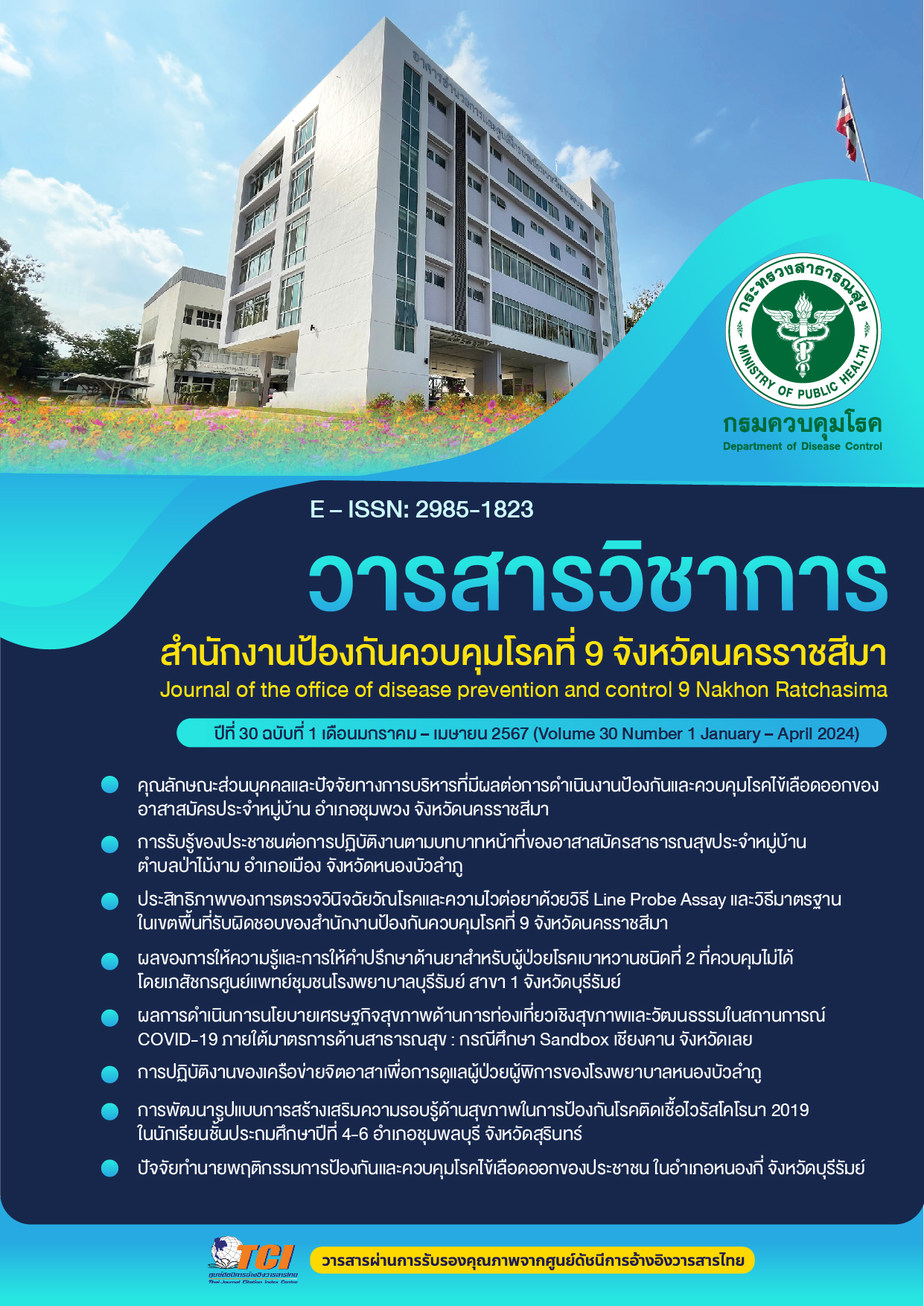The Efficacy of Tuberculosis Diagnosis and Drug Sensitivity Using Line Probe Assay and Standard methods in the Area under the Responsibility of the Office of Disease Prevention and Control 9, Nakhon Ratchasima
Keywords:
Tuberculosis, Line Probe Assay, Standard drug susceptibility testingAbstract
Mycobacterium tuberculosis (MTB) poses a significant global health challenge in Thailand, particularly Multidrug-resistant tuberculosis (MDR-TB), resistant to rifampicin and isoniazid drugs. The diagnosis of MDR-TB traditionally relies on conventional culture and drug susceptibility testing (DST) using solid and liquid mediums, which can result in a prolonged turnaround time for result interpretation. To address this issue, the Office of Disease Prevention and Control 9, Nakhon Ratchasima, introduced Line Probe Assay (LPA) for molecular diagnosis of MDR-TB, aiming to expedite the diagnostic process. A retrospective descriptive study was conducted, analyzing secondary data collected routinely from the laboratory for individual patients diagnosed with TB between October 1, 2019, and September 30, 2020. A total of 335 specimens were included in the analysis. The study aimed to compare the efficacy of LPA (Genotype MTBDRplus VER 2.0) and DST in detecting INH and RIF-resistant tuberculosis. The sensitivity, specificity, accuracy, positive predictive value (PPV), and negative predictive value (NPV) of LPA were analyzed using standard DST as a golden reference. Results from the standard DST revealed that 25 isolates (7.5%) were MDR-TB, while 25 (7.5%) were INH-resistant, and 285 (85%) were susceptible to both INH and RIF. The efficiency of LPA by Genotype MTBDRplus VER 2.0 for detecting INH-resistant, RIF-resistant, and MDR-TB showed 90%, 91.7%, and 84% sensitivity, with specificity rates of 98.9%, 99.3%, and 100%, respectively. The overall accuracy was 97.6%, 98.8%, and 98.8%, with PPV and NPV values indicating high diagnostic reliability. In conclusion, LPA demonstrated high sensitivity, specificity, and accuracy in detecting drug-resistant tuberculosis. This molecular method holds promise for facilitating early and appropriate treatment for tuberculosis patients and preventing the community spread of MDR-TB.
References
World Health Organization. Global Tuberculosis Report 2565 [อินเตอร์เน็ต]. 2565 [เข้าถึงเมื่อ 2566 มิถุนายน 28]. เข้าถึงได้จาก: https://worldhealthorg.shinyapps.io/tb_profiles/?_inputs_&entity_type=%22country%22&lan=%22EN%22&iso2=%22TH%22.
Rageade F, Picot N, Blanc-Michaud A, Chatellier S, Mirande C, Fortin E, van Belkum A. Performance of solid and liquid culture media for the detection of Mycobacterium tuberculosis in clinical materials: meta-analysis of recent studies. Eur J Clin Microbiol Infect Dis. 2014;33(6):867-70.
Chien HP, Yu MC, Wu MH, Lin TP, Luh KT. Comparison of the BACTEC MGIT 960 with Löwenstein-Jensen medium for recovery of mycobacteria from clinical specimens. Int J Tuberc Lung Dis. 2000;4(9):866-70.
สำนักวัณโรค กรมควบคุมโรค. การคัดกรองเพื่อค้นหาวัณโรคและวัณโรคดื้อยา. พิมพ์ครั้งที่ 2. กรุงเทพฯ: สำนักพิมพ์อักษรกราฟฟิคแอนด์ดีไซน์; 2561.
Makinen, J., H. J. Marttila, M. Marjamaki, M. K. Viljanen, H. Soini. Comparison of two commercially available DNA line probe assays for detection of multidrug-resistant Mycobacterium tuberculosis. J Clin Microbiol. 2006;44:350-52.
Cho E, Shamputa IC, Kwak HK, Lee J, Lee M, Hwang S, et al. Utility of the REBA MTB-Rifa® assay for rapid detection of rifampicin resistant Mycobacterium tuberculosis. BMC Infect Dis. 2013;13:478.
Rufai SB, Kumar P, Singh A, Prajapati S, Balooni V, Singh S. Comparison of Xpert MTB/RIF with line probe assay for detection of rifampin-monoresistant Mycobacterium tuberculosis. J Clin Microbiol. 2014;52:1846-52.
Bang H, Park S, Hwang J, Jin H, Cho E, Kim DY, et al. Improved rapid molecular diagnosis of multidrug-resistant tuberculosis using a new reverse hybridization assay, REBA MTB-MDR. J Med Microbiol. 2011;60:1447-54.
Tessema B, Beer J, Emmrich F, Sack U, Rodloff AC. Analysis of gene mutations associated with isoniazid, rifampicin, and ethambutol resistance among Mycobacterium tuberculosis isolates from Ethiopia. BMC Infect Dis. 2012;12:37.
Singhal R, Arora J, Lal P, Bhalla M, Myneeedu VP, Behera D. Comparison of line probe assay with liquid culture for rapid detection of multi-drug resistance in Mycobacterium tuberculosis. Indian J Med Res. 2012;136:1044-7.
Zhang M, Yue J, Yang YP, Zhang HM, Lei JQ, Jin RL, et al. Detection of mutations associated with isoniazid resistance in Mycobacterium tuberculosis isolates from China. J Clin Microbiol. 2005;43(11):5477-82.
Seifert M, Catanzaro D, Catanzaro A, Rodwell TC. Genetic mutations associated with isoniazid resistance in Mycobacterium tuberculosis: a systematic review. PLoS One. 2015;10: e0119628.
Canetti G, Fox W, Khomenko A, Mahler HT, Menon NK, Mitchison DA, et al. Advances in techniques of testing mycobacterial drug sensitivity, and the use of sensitivity tests in tuberculosis control programmes. Bull World Health Organ. 1969;41:21-43.
Cavusoglu, C., A. Turhan, P. Akinci, I. Soyler. Evaluation of the GenoType MTBDR assay for rapid detection of rifampin and isoniazid resistance in Mycobacterium tuberculosis isolates. J Clin Microbiol. 2006;44:2338-2342.
Hillemann, D., M. Weizenegger, T. Kubica, E. Richter, S. Niemann. Use of the GenoType MTBDR assay for rapid detection of rifampin and isoniazid resistance in Mycobacterium tuberculosis complex isolates. J Clin Microbiol. 2005;43:3699-3703.
Miotto, P., F. Piana, V. Penati, F. Canducci, G. B. Migliori, D. M. Cirillo. Use of GenoType MTBDR assay for molecular detection of rifampin and isoniazid resistance in Mycobacterium tuberculosis clinical strains isolated in Italy. J Clin Microbiol. 2006;44:2485-2491.
Makinen, J., H. J. Marttila, M. Marjamaki, M. K. Viljanen, H. Soini. Comparison of two commercially available DNA line probe assays for detection of multidrug-resistant Mycobacterium tuberculosis. J Clin Microbiol. 2006:44:350-352.
Meaza A, Kebede A, Yaregal Z, Dagne Z, Moga S, Yenew B, et al. Evaluation of genotype MTBDRplus VER 2.0 line probe assay for the detection of MDR-TB in smear positive and negative sputum samples. BMC Infect Dis. 2017;17(1):280.

Downloads
Published
How to Cite
Issue
Section
License
Copyright (c) 2023 The office of disease prevention and control 9th Nakhon Ratchasima

This work is licensed under a Creative Commons Attribution-NonCommercial-NoDerivatives 4.0 International License.
บทความที่ลงพิมพ์ในวารสารวิชาการสำนักงานป้องกันควบคุมโรคที่ 9 จังหวัดนครราชสีมา ถือว่าเป็น
ลิขสิทธิ์ สำนักงานป้องกันควบคุมโรคที่ 9 จังหวัดนครราชสีมา


